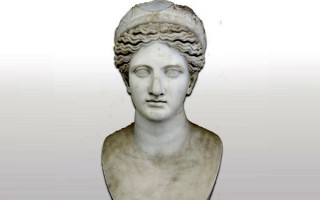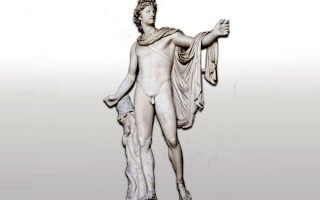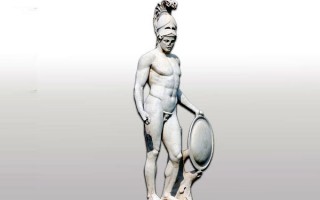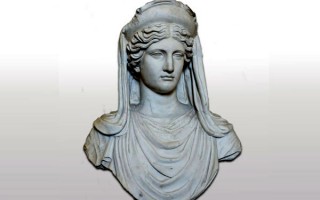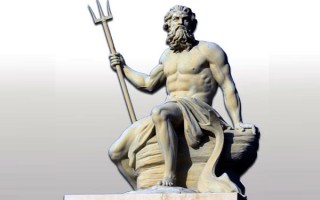- Home
- Post
- Twelve Olympus Gods +1
- Artemis
Artemis was Leto’s maidenly and wild daughter, Zeus’ untamed offspring and Apollo’s twin sister. She was the queen of mountains and woods, goddess of hunting, protectress of birth and mistress of the beasts. As a “Nykterophoitos” (wanderer of the night) and torch-bearer goddess, she would rush, in the night, onto the highest unbeaten mountain peaks along with the wind.
Her and her brother’s birth was the cause of the appearance of Delos Island in the Aegean. A sacred land, with a predetermined position in the Greek Mythology, where the two deities of Light were born: Apollo, god of the day-light and Artemis, goddess of the night-light. Their birth land, before becoming “Delos” (visible), was a floating, wandering rock, called “Ortygia” or “Adelos” (invisible). When pregnant Leto was in search of a land in order to give birth, away from Hera’s wrath, Zeus asked his brother Poseidon to help in finding a place somewhere in the sea. Poseidon then, took the invisible, floating rock “Adelos”, anchored it with four huge diamond chains and named it “Delos”. Leto, after promising Delos eternal light and prosperity, comes to the sacred lake, not far from the foot of Kythnos Mountain. She gives birth to Artemis first, all alone, since Hera had forbidden midwife-goddess Eileithyia to be present. Nine days later, with the help of the divine new-born Artemis, she gave birth to Apollo. Leto kept her promise: since that moment, Delos has been a sacred island, bathed by Apollo’s Light.
Artemis was a very sui generis goddess. From birth, she acts like midwife, becoming this way, the protectress of birth. From childhood, being always aware of her desires, she takes firm and rigid decisions. Zeus admired her persistence and her ingenuity and did all her favors. The first favor Artemis asked, as a gift, was eternal purity and virginity. She was active, tough and restless, conscious, mature and determined and she could become ruthless, without forgiveness, against the violator of her severe rules. She was the “Potnia Theron” (mistress of the beasts) and the “Agrotera” (huntress) of Homer, with a universal sovereignty on nature: tamed and wild animals, fish and birds, were all under her protection. Being the “Goddess of the Selene” (moon), according to the Orphic hymn, she was associated with the Moon and Hekate, as well. Hekate, the “Trimorphic” great goddess, is present in all three worlds (universal). But when she acquires a specific form, then the professed part of hers becomes Artemis. On the other hand, Selene (Moon) expresses the condensed ideas of the goddess, like the Sun does of Apollo. “Selene” derives from “selas”, the light which accompanies the Night and Artemis was “nykterophoitos”-night wanderer. The two goddesses are connected with a deep relation, being though different from each other. They both appear in representations, holding lit torches. Artemis incorporated many old prehistoric deities, like Vritomartys, Diktynna, Kallisto and Laphria.
Her various and diverse symbols were animals, plants and weapons. The basic ones were the arrow, the crescent and the deer.
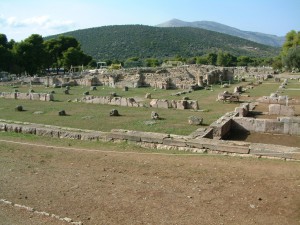 The Epidaurian sanctuary occupies a valley at the foot of Kynortion Mountain, where lots of water flows from the high springs. Here, among the sacred buildings, in the central part of the sanctuary and SA of the temple of Asclepius, is a small temple dedicated to Artemis. It was built in the end of the 4th century BC, together with the rest of the monuments of the sanctuary, which was then restored, in order to become a brilliant Art-Therapy center.
The Epidaurian sanctuary occupies a valley at the foot of Kynortion Mountain, where lots of water flows from the high springs. Here, among the sacred buildings, in the central part of the sanctuary and SA of the temple of Asclepius, is a small temple dedicated to Artemis. It was built in the end of the 4th century BC, together with the rest of the monuments of the sanctuary, which was then restored, in order to become a brilliant Art-Therapy center.The temple of Artemis was a “prostyle” structure, with 6 Doric columns at the façade and an inner Corinthian colonnade in the “Greek p” form. The temple had a Doric entablature with decorative acanthuses on the sime and water spouts in the form of boars’ and dogs’ heads instead of the ordinary lions’ heads. One can see the hunting aspect of the goddess here. According to an inscription, the Epidaurian cult of the goddess is dated from the classical era (5th century BC) and focuses on the chthonian character of the goddess, worshipped as Artemis-Hekate. This aspect of the goddess was highly connected with the chthonian Asclepius, her nephew, being the son of Apollo. Her cult statue was standing in the cella. The altar, in front of the eastern side of the temple and its façade, would offer access to the entrance of the temple, via a paved corridor.
The temple is mentioned by Pausanias and its position was testified after the discovery of an inscribed statue-base, bearing the name of the goddess, on the eastern side of the temple.
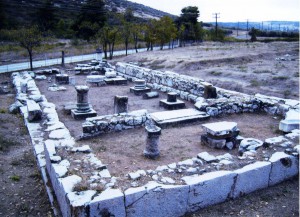 Aulis was an ancient religious center which belonged to the city of Tanagra, from the 4th century BC onwards. The sanctuary of Aulis is testified by Homer (Iliad), Strabo (9.2.8) and Pausanias (9.19.6). It is located on an outcrop of NE Boeotia, at a bay, called “Mikro Vathy”, in the southern coast of the Euboean Gulf. The site is reached via the road from Athens to Chalkis. The sanctuary, within an industrial area, today, was discovered in 1941. It was excavated by Ioannis Threpsiades in 1956. The road that crosses the archaeological site has been called I. Threpsiades Street in his honor. Aulis is known from the Trojan War and the sacrifice of Iphigenia. Agamemnon was forced to sacrifice his daughter, Iphigenia, to infuriated Artemis, in order to let the fair wind free, permitting this way, safe sailing towards Troy. The 1.000 ships of the Greek fleet were, most probably, anchored at the more suitable bay of Glyfa, near Chalkis, some distance away from the small bay of Aulis.
Aulis was an ancient religious center which belonged to the city of Tanagra, from the 4th century BC onwards. The sanctuary of Aulis is testified by Homer (Iliad), Strabo (9.2.8) and Pausanias (9.19.6). It is located on an outcrop of NE Boeotia, at a bay, called “Mikro Vathy”, in the southern coast of the Euboean Gulf. The site is reached via the road from Athens to Chalkis. The sanctuary, within an industrial area, today, was discovered in 1941. It was excavated by Ioannis Threpsiades in 1956. The road that crosses the archaeological site has been called I. Threpsiades Street in his honor. Aulis is known from the Trojan War and the sacrifice of Iphigenia. Agamemnon was forced to sacrifice his daughter, Iphigenia, to infuriated Artemis, in order to let the fair wind free, permitting this way, safe sailing towards Troy. The 1.000 ships of the Greek fleet were, most probably, anchored at the more suitable bay of Glyfa, near Chalkis, some distance away from the small bay of Aulis.The greater area of Aulis was inhabited in the Mycenaean era (16th – 12th century BC). An apsidal structure of the Geometric years (10th – 8th century BC) has been found under the ruins of the classical temple of Artemis. Her sanctuary includes the temple, the sacred fountain and other buildings of the Hellenistic Age (3rd – 2nd century BC), together with the “thermes” (baths) of the late Roman years.
The classical temple of Artemis was built in the 5th century BC, probably over the ruins of an older one. It is a temple of 9,40 x 31 meters, with a “pronaos” at the façade and a cella divided in three aisles with two rows of Ionic columns and a marble door leading to an Adyton. The statues of Artemis and Apollo would stand at the entrance of the Adyton. Statues, dedication bases, small “thesauruses” and tables of offerings were found inside the temple.
The sacred fountain, with the “aglaon hydor” (bright clean water) of Homer, is located east of the temple, surrounded by a wall. The water was pumped from a nearby square cistern, accessible by a staircase. It is possible that the cult of Artemis, initially, started from that spring and the outdoor altars, around it (Iliad Β, 303-307). In the Hellenistic period, a group of buildings was built around the central square, dated from the 3rd and 2nd century BC, south of the temple. Some of the buildings functioned as potters’ workshops, while one of them functioned as “xenon” (hostel) for the visitors. Later, after the destruction of the temple in 396 AD, “thermes” (baths) would cover its ruins which were used as constructive material.
Aulis became the scene of an event, described by Homer in his Iliad: a huge, three-headed monster with a crimson back, which appeared at Aulis the moment of a sacrifice, under the plane tree of the sacred spring, swallowed 8 small sparrows and their mother. The monster disappeared immediately after the event. This was the unmistakable sign, interpreted by the unsighted seer Kalchas: the Greeks would besiege Troy, for 9 years, before they conquer the city on the 10th year. Homer mentions that a piece of this huge plane tree had survived, in his years and Pausanias, about 1000 later from Homer, informs us that the sacred piece was kept in the temple: we may presume that the stone base, next to the 2nd column, from the entrance, may have been the spot where that piece was supported.
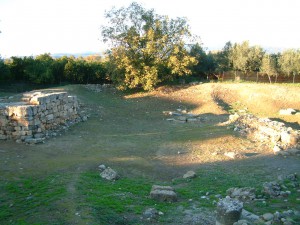 The major Spartan sanctuary of Artemis “Orthia” was built near the west banks of Eurotas River, at the ancient municipality of Limnes, very close to the gate of the ancient city. Today, the visitor of the sanctuary site can see the crepis of the temple, the traces of the altar and parts of the foundations of the theater.
The major Spartan sanctuary of Artemis “Orthia” was built near the west banks of Eurotas River, at the ancient municipality of Limnes, very close to the gate of the ancient city. Today, the visitor of the sanctuary site can see the crepis of the temple, the traces of the altar and parts of the foundations of the theater.The sanctuary of Artemis Orthia was the religious center of the young Spartan “agoge” (education), a very important issue for the Spartan state, where discipline, in certain rules, was a matter of survival.
According to the excavators, the cult of Artemis started, in Sparta, in the 9th century BC. Initially, the sanctuary comprised of an outdoor temenos and an altar. The first temple was built in the 8th or 7th century BC and was destroyed in the 6th century BC from a flood of the river. A new temple was built over the ruins, which is visible nowadays. A rectangular altar survives, in front of it, built of large stone slabs.
This second temple went through some restoration phases in the end of antiquity. A big change in the site happened in the 3rd century AD, when a theater was built, east of the temple and a new, larger altar, was built closer to the temple. The pilgrims and the spectators would attend the ritual contests of young Spartans in the theater. Clay masks have been found inside the theater, probably used in orgiastic rites that took place in the sanctuary. The marble stelae with the sickles and the inscribed altars were dedications of the young Spartans who had passed the “test”, called “Diamastigosis” (striping) and had managed to be classified as “epheboi”.
According to Pindar, the ancients believed that “Orthia” or “Orthasia” Artemis supported the raising of the children or upraised those who had fallen. Pausanias (Laconika 16, 7) says that the “xoanon” (wooden cult statue) of the goddess, had been stolen from Taurike, by Orestes and Iphigenia and was brought to Sparta by them. This xoanon was called “Orthia” and “Lygodesma” as well, meaning “tied up by wicker branches”. Having found it, tied up with the branches of a wicker tree, Orestes and Iphigenia had to carry it in an upraised position (“Orthia”). The epithet “Orthia” most probably, belonged to a Mycenaean goddess of fertility with whom Artemis was identified later in the historic years. We know, from Pausanias, that when the Spartans found the “xoanon” of the goddess, they turned insane and, during the sacrifice in honor of the goddess, they started fighting against each other and many were killed on the altar. The oracle of Delphi advised them to sprinkle the altar with human blood, as atonement, for the sacrilege of accepting the stolen “xoanon”. Lykourgos, the wise Spartan law-giver then, established a religious festival including the striping of the young Spartans on the altar, instead of the human sacrifice. This was the ritual of endurance, called “Diamastigosis”. During the festival, crowds of people watched the rituals, the sacred dances and the races.
The Spartan children (age between 7-13 years) participated in the contests, divided in three age groups. The prize was always an iron sickle. The contests included a kind of chase, called “katheratorion”, a singing performance, called “moa” (muse) and recitation, called “kelea”. The older children participated in the “Diamastigosis” which took place at the altar. The winners were called “vomonikes” (altar-winners). Juicy pliable rods were used for the striping: they believed that the miraculous herbal power, which makes the trees grow, was transferred to the striped body thus making it stronger.
The excavations have testified that ritual dances, in honor of the goddess, would take place around the altar of the goddess, by disguised citizens wearing masks, just like in the theaters.
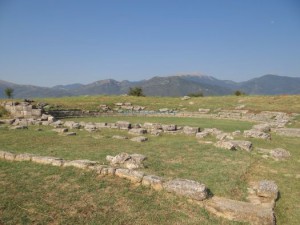 On the western slope of Gortsouli hill, at the area of ancient Mantineia, the ruins of an archaic temple enlighten our knowledge regarding the history of the pre-classical city of Mantineia. Gortsouli is identified with “Ptolis”, mentioned by Pausanias (8.8.4) as the prehistoric acropolis of the ancient city of Mantineia. During the Archaic Age (7th – 6th century BC), Ptolis became the central sanctuary of the Mantineians who still lived in villages (“komae”), in the plain at the foot of the hill. The excavations have testified that an outdoor cult was being practiced in the site, with no interruption from the end of the 8th till the 6th century BC. After an unsuccessful attempt to build a temple in the 7th century BC, due to the collapse of the newly built foundations down the hill, the temple was, finally built a century later. The same blocks of stone were reused for the new temple which was built on the pre-existing foundations and functioned till the 3rd century BC.
On the western slope of Gortsouli hill, at the area of ancient Mantineia, the ruins of an archaic temple enlighten our knowledge regarding the history of the pre-classical city of Mantineia. Gortsouli is identified with “Ptolis”, mentioned by Pausanias (8.8.4) as the prehistoric acropolis of the ancient city of Mantineia. During the Archaic Age (7th – 6th century BC), Ptolis became the central sanctuary of the Mantineians who still lived in villages (“komae”), in the plain at the foot of the hill. The excavations have testified that an outdoor cult was being practiced in the site, with no interruption from the end of the 8th till the 6th century BC. After an unsuccessful attempt to build a temple in the 7th century BC, due to the collapse of the newly built foundations down the hill, the temple was, finally built a century later. The same blocks of stone were reused for the new temple which was built on the pre-existing foundations and functioned till the 3rd century BC.In general, the 6th century-building presents many similarities with its unlucky predecessor: a significant prolongation of the axis oriented from north to south, with the narrow entrance in the southern side. It comprises of a “prodomos” (anteroom), a “sekos” (cella) and an Adyton (enclosed sanctuary, not accessible to all), with internal dimensions of 14.60 x 4.65 meters.
Votive offerings of significance were discovered in the interior of the temple. The most precious group of offerings includes clay figurines representing exclusively feminine figures, in an impressive variety of types. These votive offerings are dated between the 7th and the early 5th century BC and testify the cult of goddess Artemis, as protectress of vegetation and as “kourotrophos” (breeder of babies). Among the types of figurines, one distinguishes for its imposing veil-bearers of significant height; it is the first time that such a type of figurines occurs. Also noteworthy, among the excavation finds, is an ensemble of iron pins, unparalleled in volume and state of preservation, recalling as to the typology the bronze pins that were also found in abundance within the temple. Many of the finds are displayed in the Archaeological Museum of Tripolis.
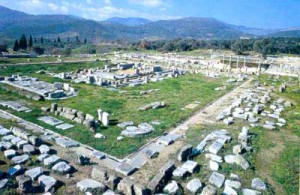 The studies in the area start in 1843, when Ph. Le Bas studied the foundations of an Ionic small temple, an altar and a peribolos wall. The ruins were located at the site of “Spelouza”, on a terrace of Ithome Hill, NE of Mavrommati village. The inscriptions that were found, during the excavations, have identified the ruins with the sanctuary of Artemis. For many years, the site was hidden in the dense vegetation and, only after the recent work of P. Themelis in the greater site of ancient Messene, it was brought to light.
The studies in the area start in 1843, when Ph. Le Bas studied the foundations of an Ionic small temple, an altar and a peribolos wall. The ruins were located at the site of “Spelouza”, on a terrace of Ithome Hill, NE of Mavrommati village. The inscriptions that were found, during the excavations, have identified the ruins with the sanctuary of Artemis. For many years, the site was hidden in the dense vegetation and, only after the recent work of P. Themelis in the greater site of ancient Messene, it was brought to light.In the middle of the Ionic temple, the limestone pedestal of the cult statue is still in situ. Additionally, the altar and a part of the peribolos wall, together with auxiliary buildings have been revealed. Le Bas proposes that this Artemis “Limnatis”, of the inscriptions, should be identified with “Laphria”, a prehellenic deity of nature, life and death. This argument is also testified by Pausanias who mentions only Laphria in the sanctuary and not Limnatis. Moreover, he mentions her cult statue, as the work of the Messenian sculptor Damophon and rituals that took place in honor of Artemis Laphria. The cult of Laphria was introduced to the sanctuary on Ithome by the Kalydonians.
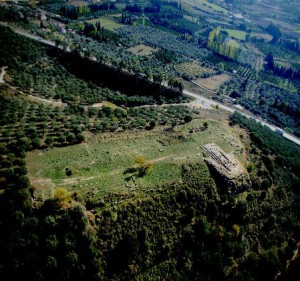 The “petroessa” (rocky) Kalydona of Homer, built on a rocky slope by Evenos River, was a major city in ancient Aetolia. Today, the ruins of the city are observed north of the village Evenochori by the National Road.
The “petroessa” (rocky) Kalydona of Homer, built on a rocky slope by Evenos River, was a major city in ancient Aetolia. Today, the ruins of the city are observed north of the village Evenochori by the National Road.Access to the sanctuary of Artemis “Laphria” starts with the Sacred Way, from the SW gate of the fortification wall of the city and continues, out of the walls. The Sacred Way ends at the sanctuary, which is located west of the city, on a separate hill. This sanctuary was the second Aetolian sanctuary in importance, after the one of ancient Thermos, above Lake Trichonis. Here, together with Artemis Laphria, Apollo Laphrios is worshipped. There are two interpretations regarding the epithet “Laphria”: either Laphria derives from Laphrios, the name of the donor of the cult statue of the goddess or “Laphria” means “lightweight”, since the wrath of the goddess against king Oineas became lighter with the years. Oineas, the famous king of Kalydona and father of Meleagrus, when sacrificing to the gods, had forgotten Artemis who was infuriated and sent the “kalydonian” boar against the Aetolians.
The most ancient signs of the cult of Artemis Laphria are dated from the Geometric era (8th – 7th century BC), as it has been testified by the discovery of an apsidal structure. The peak of the prosperity of the sanctuary is placed in the Archaic era (6th century BC). The prominent location of the sanctuary offers beautiful views towards the river delta of Evenos.
The sanctuary was brought to light in the beginning of the 20th century and all the information of the excavations has been published in the book «Das Laphrion», in 1948, in Copenhagen by Dyggve and Poulsen, who dedicated it to the “Heroic Town of Mesolongi”.
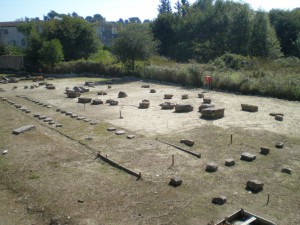 The temple is located at Ayioi Theodoroi. It was recovered incidentally, when fragments of its giant pediment were discovered in the area. Today, these fragments are displayed in the Archaeological Museum of Corfu, being the oldest of the monumental stone pediments of ancient Greek art. The temple is Doric, built in 590-580 BC, with a three-aisled cella, a “pronaos” (ante cella) and an “opisthodomos” (rear chamber).
The temple is located at Ayioi Theodoroi. It was recovered incidentally, when fragments of its giant pediment were discovered in the area. Today, these fragments are displayed in the Archaeological Museum of Corfu, being the oldest of the monumental stone pediments of ancient Greek art. The temple is Doric, built in 590-580 BC, with a three-aisled cella, a “pronaos” (ante cella) and an “opisthodomos” (rear chamber).The big stone pediment which decorated the western side of the temple comprises of a central scene with the Gorgo (Medusa) and the lion-panthers on either side of it and an angular decoration with scenes of the Titanomachy.
A paved road, 3 meters wide, connects the temple with an altar whose southern side is now under the church of Ayioi Theodoroi. The altar comprises of the foundations and a Doric pedestal with triglyphs and metopes. A part of a big retaining wall runs along the northern side of the temple, with the “krepidoma” (floor) of a stoa, in front of it.
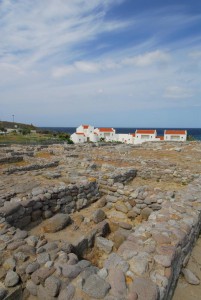 Artemis was the protectress of the ancient city of Myrina. Inscriptions have testified the ruins, found in the land plot of “Porto Myrina” Hotel, as part of the great sanctuary of Artemis. According to the inscriptions, there existed two sanctuaries: a small one within the ancient city walls and a bigger one outside the walls, as per the local custom.
Artemis was the protectress of the ancient city of Myrina. Inscriptions have testified the ruins, found in the land plot of “Porto Myrina” Hotel, as part of the great sanctuary of Artemis. According to the inscriptions, there existed two sanctuaries: a small one within the ancient city walls and a bigger one outside the walls, as per the local custom.The location of the particular sanctuary was indicated by a gigantic goat which would appear in front of travellers during the night.
The sanctuary comprised of a central, open-air, paved court, surrounded by various auxiliary buildings, used by the priests either for the storage of supplies or for the daily cult services. It was enclosed by a double wall with two entrances: one towards the city and the other towards the water, an indication of the existence of a harbor. Among the ruins, three wells and a chamber with inner benches, NW of the sanctuary, testify mystic initiation rituals where ritual water was an important component and initiation gatherings took place. The sanctuary had a long life more than 8 centuries, starting from the early Archaic era (7th century BC) and reaching the end of Antiquity.
The excavation brought to light a plethora of artifacts, including a wealth of ceramics, figurines, perfume vessels, loom weighs and jewelry, exhibited in the Archaeological Museum of Myrina. The bull figurines found within the traces of a sacrificed bull, indicate a connection between Artemis of Lemnos with the Brauroneian Artemis, which can be explained by the fact that Lemnos was at a crossroads of civilizations’ interactions through trade.
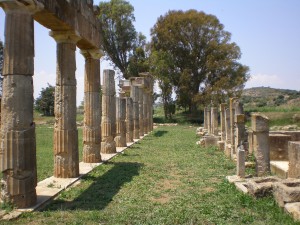 The Doric temple of Artemis which is located on the NW outcrop of the rock of the acropolis, on a stepped terrace, stood out, above all the rest of the sacred buildings. It was built of local porus stone, in the end of the 5th century BC, replacing an older archaic temple. The chapel of Saint George is actually standing over the ruins of that archaic temple.
The Doric temple of Artemis which is located on the NW outcrop of the rock of the acropolis, on a stepped terrace, stood out, above all the rest of the sacred buildings. It was built of local porus stone, in the end of the 5th century BC, replacing an older archaic temple. The chapel of Saint George is actually standing over the ruins of that archaic temple.The cult statue of Artemis has not survived. We know, though, that it was called “agalma orthon” (upraised statue), as it is mentioned on inscriptions found on the Acropolis of Athens. It was attributed to Praxiteles by Euripides, Pausanias and Plutarch.
Here, at the sanctuary, Artemis was co-worshipped with her mother Leto, her brother Apollo, god Dionysos and, primarily, with Iphigenia. The rich dedications that were found, during the excavations, testify the worship of Artemis as the goddess of nature, kourotrophos, protectress of children and little animals. A stately procession (“theoria”) started, every 5th year, from the Acropolis of Athens, in order to reach Brauron, for the celebration of the “Brauronia” festival. Sacrifices, rituals, athletic and music contests and chariot races were held in honor of the goddess, while the important feature of the festival was the ritual of “Arkteia”: an initiation ritual of the young girls, called “arktoi”, before the age of puberty.
The sanctuary of Brauroneia Artemis was located north of the sanctuary of Tauropolos Artemis, at modern Loutsa, in the ancient demos of Araphenides Ales. It was connected with Iphigenia who was the high priest of Artemis and was worshipped in Brauron as a chthonian heroine. Her cult center was a cave which housed her tomb.
 The temple’s ruins are located at the cross-section of Ardettos and Koutoula Streets, close to the site of the Olympieion and beyond the Swimming Center. None of the surviving architectural finds can give us an idea of the complete form of the temple, since only fragments of the foundations are in situ. A testimony of the monument as it stood in 1753, is given by the detailed drawings of elevations, ground plans, members of the temple and its pediment (now in the Museum of Berlin and Venice) executed by architects J. Stewart & N. Revett on their visit to Athens.
The temple’s ruins are located at the cross-section of Ardettos and Koutoula Streets, close to the site of the Olympieion and beyond the Swimming Center. None of the surviving architectural finds can give us an idea of the complete form of the temple, since only fragments of the foundations are in situ. A testimony of the monument as it stood in 1753, is given by the detailed drawings of elevations, ground plans, members of the temple and its pediment (now in the Museum of Berlin and Venice) executed by architects J. Stewart & N. Revett on their visit to Athens.Artemis Agrotera (huntress), among other deities, was connected with the victory of the Athenians against the Persians, in the Battle of Marathon (490 BC) and her cult was introduced to the city of Athens with great enthusiasm. Ancient sources (Aristophanes, Plutarch, Xenophon, and Ailianus) describe annual sacrifices in honor of the goddess, commemorating the great victory, at her sanctuary, located on the southern banks of Ilissos River. Pausanias calls this location “Agrae”.
The temple was converted into a Christian basilica in the 5th century and much later in the 17th century, with the addition of a dome, into the church, dedicated to Virgin Mary known as “Panagia stin Petra”. It was thoroughly destroyed in 1778 by the Ottoman Turks who used it as a quarry for the city’s fortifications.
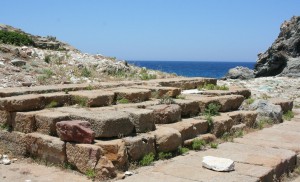 The foundations of the temple of Artemis Tauropolos which were recovered, in 1925, at the coast of Loutsa, were thoroughly studied (1956-57) by the Archaeological Society. They belong to a Doric, peripteral temple, with a cella, comprising of two sections: a spacious eastern, main chamber and an Adyton, behind it. It was built in the end of the 5th century BC.
The foundations of the temple of Artemis Tauropolos which were recovered, in 1925, at the coast of Loutsa, were thoroughly studied (1956-57) by the Archaeological Society. They belong to a Doric, peripteral temple, with a cella, comprising of two sections: a spacious eastern, main chamber and an Adyton, behind it. It was built in the end of the 5th century BC.Euripides and, later, Menander in his comedy “Epitrepontes”, present information about the “Tauropolia”, the religious festival, in honor of the goddess: night parades, Dionysian rituals and mimics of human sacrifices. The sanctuary of Tauropolos was the religious center of the ancient demos “Alos Araphenidon” which belonged to the city-state of Athens. It functioned from the 7th till the 1st century BC, as it is testified by the votive offerings.
Apart from the temple, two “propyla” (elaborate entrances), a cobbled path and some pedestals were revealed, during the excavations. A small temple with an “apothetes” (sacred dumping place) has been discovered, 200 meters south of the temple, containing a plethora of dedications dated from the Geometric and the Classical era. All the finds are displayed in the Archaeological Museum of Brauron.
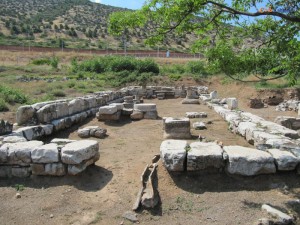 The promontory of Artemision took its name from Artemis “Proseoa” who was worshipped in the region. The epithet “Proseoa” derives from the word “eos” (aurora), meaning she who looks towards dawn. Artemision which is located on the north tip of Euboea Island, opposite Pelion Mountain, has become known from the Sea Battle (of Artemision) between the Greeks and the Persians in August, 480 BC. The sanctuary of Artemis was right at the coast, where the Greek fleet was docked (Herodotus, Historiae Ζ΄ 176 / Plutarch). The strategic position of the region, controlling the narrow pass between the Aegean Sea and the Gulfs of Maliakos, Pagasetic and Euboean, brought a great prosperity to the region during the ancient times. Up to now, there has not been any essential research in the area or excavations and the information we get, derives from the surface ruins and the few written sources.
The promontory of Artemision took its name from Artemis “Proseoa” who was worshipped in the region. The epithet “Proseoa” derives from the word “eos” (aurora), meaning she who looks towards dawn. Artemision which is located on the north tip of Euboea Island, opposite Pelion Mountain, has become known from the Sea Battle (of Artemision) between the Greeks and the Persians in August, 480 BC. The sanctuary of Artemis was right at the coast, where the Greek fleet was docked (Herodotus, Historiae Ζ΄ 176 / Plutarch). The strategic position of the region, controlling the narrow pass between the Aegean Sea and the Gulfs of Maliakos, Pagasetic and Euboean, brought a great prosperity to the region during the ancient times. Up to now, there has not been any essential research in the area or excavations and the information we get, derives from the surface ruins and the few written sources.The sanctuary of “Proseoa” Artemis is located on the low hill called Ayios Georgios, at Pefki, south of the road that leads from Histiaia to Artemision and Chalkis. Plutarch has given a description of it, mentioning a small temple, in a grove, surrounded by lots of dedicatory stelae. One of them belonged to the trophy, dedicated by the Athenians, after the war.
We do not know when the sanctuary was established or its course through history. We deduct some information from two inscriptions about its history and the cult of Artemis. The first one which is kept in the Epigraphic Museum is dated from the 2nd century BC and mentions names of people who participated in a restoration of the sanctuary and the dedication of a cult statue. A big amount of money -8.125 drachmas- was collected for this purpose. The second inscription is dated from the 4th or the 5th century BC and refers to the “pyrrichios” dance which was danced in honor of goddess Artemis. Most probably, the dance was danced by the young people, in commemoration of the Sea Battle of Artemision. There is also a hermaic “stele” (shaft), which is now displayed in the Archaeological Museum of Oreoi and is dated from the 5th century BC. This stele was dedicated to the sanctuary of the goddess by Kephalus, the son of Hegemon and was placed at the entrance of the temple. The German archaeologist G. Lolling excavated the site, just for 7 days, in 1883. This short, but important excavation brought the sanctuary to light, for a while. Very soon, the ruins returned to their darkness, after the construction of the church of Saint George, followed by the establishment of a cemetery, on the same spot. Lolling’s excavation seems to have been forgotten, but, at least, the cemetery has been relocated, leaving the site free for further investigation
Although all the finds of Lolling’s excavation are gone, we know that he had found a few traces from the temple, fragments from the walls and entablature, a part of a clay sime and some “akrokerama” (top tiles). Additionally, the excavator has mentioned that the sculptures were made of white marble, belonging to the fragment of the torso of a female statue and to some stelae. Today, the only surviving find is the inscription of Artemision.
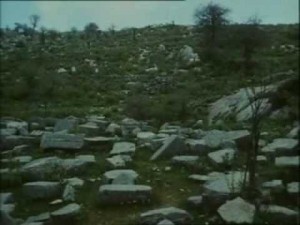 Bassae is located south of the Arcadian town of Andritsaina, on the western slopes of Kotylion Mountain and near the ancient city of Phigaleia. The mountain is scored with “vassai” (ravines), which give the place its name. In this bare, rocky landscape, 1131 metres above sea level, the people of Phigaleia founded a sanctuary in honour of Apollo. A sacred road connected the sanctuary with the city, nearly thirteen kilometres away. The sanctuary was dominated by one of the most imposing monuments of ancient Greece: the temple of Apollo Epikourios. The temple dedicated to Artemis is located in a separate sanctuary, on an upper terrace, NW of the temple of Apollo.
Bassae is located south of the Arcadian town of Andritsaina, on the western slopes of Kotylion Mountain and near the ancient city of Phigaleia. The mountain is scored with “vassai” (ravines), which give the place its name. In this bare, rocky landscape, 1131 metres above sea level, the people of Phigaleia founded a sanctuary in honour of Apollo. A sacred road connected the sanctuary with the city, nearly thirteen kilometres away. The sanctuary was dominated by one of the most imposing monuments of ancient Greece: the temple of Apollo Epikourios. The temple dedicated to Artemis is located in a separate sanctuary, on an upper terrace, NW of the temple of Apollo.The epithet “Orthasia”, “Orthosia” or “Orthia” is identified with Artemis, as she was worshipped in Sparta, from where the cult was transferred to other areas, like Bassae of Arcadia
The temple of Artemis Orthasia, protector of small children, stands in the small valley of Kotylion, at an altitude of 1.230 meters. The temple was erected in the Archaic period along with another temple dedicated to Aphrodite, next to it, possibly by poor Phigaleians from Bassae, which accounts for the poor construction technique. The finds from this area (bronze mirrors, terracotta female busts and the bones of sacrificial animals) indicate that both temples were used throughout the Archaic and Classical periods.
The temple has a cella with a pronaos, and its walls were built of roughly cut stone bonded with clay. There are no traces of columns or sculptural decoration. Like the temple of Apollo, it is orientated north-south instead of the usual east-west of ancient temples. North of the temple is a low limestone pedestal, which may have supported a cult statue. An emancipation inscription engraved on a bronze plaque, found at the temple’s southeast corner, mentions the worship of Artemis “Orthasia”, Apollo “Vassitas” and Pan “Sinois”.
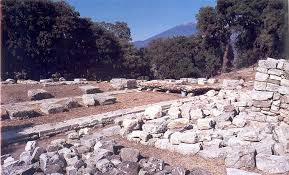 The ancient site of Lousoi is reached via the road connecting Kalavryta with Kato Lousoi village, in Achaia region. Upon arrival at Kato Lousoi, one has to take the western mountain-road towards the ancient site. Ancient Lousoi is spread on the Soudena plain, at the foot of Aroania Mountain (Chelmos), on a height of 1.200 meters. The ruins of the city are located in the woods of Prophet Elias which separates Soudena plain from the plain of Kleitoria to the south. Lousoi was an autonomous thriving ancient city until it was taken over by the Kleitorians.
The ancient site of Lousoi is reached via the road connecting Kalavryta with Kato Lousoi village, in Achaia region. Upon arrival at Kato Lousoi, one has to take the western mountain-road towards the ancient site. Ancient Lousoi is spread on the Soudena plain, at the foot of Aroania Mountain (Chelmos), on a height of 1.200 meters. The ruins of the city are located in the woods of Prophet Elias which separates Soudena plain from the plain of Kleitoria to the south. Lousoi was an autonomous thriving ancient city until it was taken over by the Kleitorians.The Austrian Institute of Athens commenced their excavations, in 1898, starting with the chapel of Panagia of Lousikon, built of ancient material from the temple of Artemis. The foundations of the temple were revealed, together with other buildings like the “bouleuterion” (assembly house), “propylon” (entrance), monumental fountain, smaller shrines and retaining walls, all dated from the 4th – 3rd century BC. The existence of an earlier temple was testified by the discovery of a fragment of the goddess’s cult statue, dated from the 6th century BC.
The new excavations have brought to light votive offerings dated from the Geometric era (end of the 8th century BC) and up to the early Classical period (early 5th century BC): a bronze scarab, bronze, silver and iron jewelry, glass and amber beads, lots of lead and bone items. Among the ceramic finds, a rare group of vessels has been found with impressed motifs of the 8th century BC. The typology of the clay figurines is of the Peloponnesian type with a typical local hair style.
The epithet “Hemera” is explained by Backchylides: the daughters of the king of Tiryns, Proitus, were cured by Melambus from insanity, with the intervention of Artemis. Out of gratitude, the princesses introduced ritual dances in honor of Artemis and founded a sacred grove where an altar was erected in order to be sprinkled with the blood of sacrificed goats and sheep. Ever since Artemis was called “Hemera” or “Hemerasia” (good willed, propitious). A big festival, called “Hemerasia” was established then, during which locals and foreigners participated in contests and races for the propitiation of the goddess. There is a plethora of ancient sources mentioning the sanctuary. Inscriptions of the 3rd century BC preserve the names of consuls and benefactors of the sanctuary. Kallimachus, in his hymn to Artemis, refers to the goddess’s temple at Lousoi. From Polybius (IV 18.9 and 34.9) we know that once, during a war, the Aetolians reached the sanctuary and after negotiations with the locals, they received a lot of the sanctuary’s treasures, as gifts in order not to destroy it. Finally, the Aetolians did not keep their word and left having committed sacrilege by catching the sacred animals of Artemis, being the sanctuary’s property.


